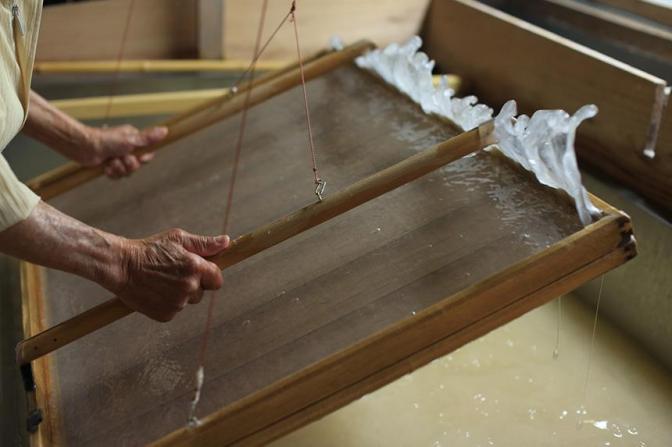Washi – a term that literally means ‘Japanese paper’ refers to the paper that’s extremely important to Japanese woodblock art. While you could do Japanese woodblock art on absolutely any paper, you might encounter several obstacles when attempting to do so on every other paper [2]. Some such problems might be that the ink bleeds right through the paper and tears it up, or when the paper is dampened to stick to the woodblock for printing, it might not be able to sustain the wetting and would have some tears here and there. This is because, unlike most Western impressionist art where oil-based ink is painted onto paper, Japanese woodblock art involves pressing a paper against a woodblock piece covered in water-based ink [3]. So what you really want when looking for the right kind of paper to do Japanese woodblock art on, is that the paper’s thin but sturdy. And that’s what Washi paper is.
You might ask, how is paper made such that it’s sturdy but thin? That seems like an impossible task, doesn’t it? Well, let’s break it down. Washi paper is made from a special Japanese technique known as nagashi-zuki – a method unique to Japan [4]. With this paper, the ink absorbs evenly, and the paper doesn’t tear.
There are several steps to this washi paper-making technique: harvesting, steaming, stripping, selecting, and sheeting, in this order.
First comes harvesting. This is where we get into what washi paper is made from. Most washi paper is made from the kozo trees or the
bushes gampi and mitsumata [4]. These are all members of the mulberry tree family. All three of these shrubs grow all around the year and are harvested in the winter months i.e. December and January. So this is the step where you gather the materials for the paper. Once you’ve picked up branches from the shrubs, up comes the steaming step, where you separate the stems of these plants and boil them in steam to soften them up. Then follows the stripping process, where you strip the branches and carefully remove the bark. Then you boil these barks again. This would remove any possible
impurities from the barks and allow you to select the best ones out of those that were collected. With the boiling, you’ll get a pulpy paper solution, that will be spread onto a mat to build the fibers [5].
Once spread as evenly as possible, and as thick as required, the paper is left to dry out in the open. And there you have your washi paper in a few hours. A few more cuttings to even out the edges etc. and you’re good to go!
Then if you want to be pickier about it, you can have three kinds of washi paper with different fiber textures each: ganpishi, kozogami, and mitsumatagami. If you’re one of the keen-eyed ones, you probably would’ve noticed that these names basically just come from the material used to make them, of the three that we mentioned above.
Now onto Japanese ukiyo-e and how washi paper is important to it. As seen in the works of
famous ukiyo-e artists of the Edo period such as Katsushika Hokusai Japanese woodblock prints often contain several fine details that collectively make it the masterpiece that it comes out to be. Your typical bamboo paper might be hot pressed and have the same weight as the washi paper, but if you try to print the woodblock print on both these papers and have a close look, you’ll see that the bamboo paper will be missing quite a few details that you see in the washi paper print. And those details are what actually add life to the print. So to sum it up, that extra magic to the Japanese woodblock prints that your bamboo paper print might be missing – is the Washi paper effect.
And this paper could actually serve as a marker for whether a ukiyo-e piece is an original or a reproduction. So the next time you go out to buy Japanese woodblock art, keep a look out for the kind of paper the print has if you’re looking for an original one.
Click here to find Japanese woodblock print originals made on Washi paper: Find our wide selection of woodblock prints for sale.
Links
[1] Barrett, Timothy: “Japanese Papermaking: Traditions, Tools, and Techniques”, New York & Tokyo: Weatherhill, 1983
[3] Hunter, Dard: “Papermaking – The History and Technique of an Ancient Craft”; Knopf, New York, 1943 and 1978
[4] Jugaku, Bunsho: “Paper-making by hand in Japan”, Meiji-Shobo Publishers, Tokyo, 1959
[5] Narita, Kiyofusa: “Japanese papermaking”, Hokuseido Press, Tokyo, 1954
[6] Newland, A.R. (editor): The Hotei Encyclopedia of Japanese Woodblock Prints (Vol. 2). Amsterdam: Hotei Publishing, 2005, pp. 434, 444, 463, 468.


